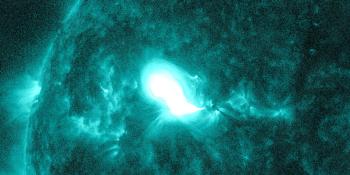Viewing archive of Monday, 17 July 2000
Solar activity report
Any mentioned solar flare in this report has a scaling factor applied by the Space Weather Prediction Center (SWPC). Because of the SWPC scaling factor, solar flares are reported as 42% smaller than for the science quality data. The scaling factor has been removed from our archived solar flare data to reflect the true physical units.
Report of Solar-Geophysical Activity 2000 Jul 17 2200 UTCPrepared by the NOAA © SWPC and processed by SpaceWeatherLive.com
Joint USAF/NOAA Report of Solar and Geophysical Activity
SDF Number 199 Issued at 2200Z on 17 JUL 2000IA. Analysis of Solar Active Regions and Activity from 16-2100Z to 17-2100Z SOLAR ACTIVITY WAS MODERATE. SEVERAL REGIONS PRODUCED
SMALL M-CLASS FLARES. REGION 9090 (N12E59) PRODUCED AN M1/1N EVENT
AT 16/2147Z; REGION 9077 (N18W46) PRODUCED AN M1/2F AT 17/0004Z; AND
REGION 9087 (S12 E31) GENERATED AN M1/1F AT 17/1344Z AND AN M2/1N AT
17/2027Z WITH A 280 SFU BURST AT 2695 MHZ AND A TYPE II. REGION
9077 SLOWLY DECLINED DURING THE PERIOD. REGION 9087 EXHIBITED
GROWTH. THE OTHER SIGNIFICANT REGIONS ON THE DISK WERE
PREDOMINANTLY STABLE. A LARGE MASS EJECTION WAS OBSERVED OVER THE
EAST LIMB AROUND 17/1100Z.
IB. Solar Activity Forecast
SOLAR ACTIVITY SHOULD BE MODERATE TO
HIGH. THE THREE REGIONS MENTIONED ABOVE ARE OBVIOUSLY CAPABLE OF
OCCASIONAL M-CLASS EVENTS. CONTINUED GROWTH IN REGION 9087 WOULD
INCREASE THE FREQUENCY OF M-CLASS EVENTS FROM THAT LOCATION. THERE
REMAINS A POSSIBILITY OF A MAJOR FLARE FROM REGIONS 9077, 9087, AND
9090.
IIA. Geophysical Activity Summary 16-2100Z to 17-2100Z
THE GEOMAGNETIC FIELD WAS QUIET TO UNSETTLED. SOLAR WIND VELOCITY
DECLINED DURING THE PERIOD FROM APPROXIMATELY 750 TO 600 KM/S. THE
GREATER THAN 10 MEV PROTON FLUX BEGAN THE PERIOD AT APPROXIMATELY
180 PFU AND BY ISSUE TIME WERE NEAR 50 PFU. THE POLAR CAP
ABSORPTION EVENT ENDED AT 17/1943Z. THE FORBUSH DECREASE REMAINED
IN PROGRESS.
IIB. Geophysical Activity Forecast
THE GEOMAGNETIC FIELD SHOULD BE
PREDOMINANTLY QUIET TO UNSETTLED FOR THE NEXT THREE DAYS. ISOLATED
ACTIVE PERIODS ARE POSSIBLE AS LONG AS SOLAR WIND VELOCITY REMAINS
ELEVATED. THE SOLAR PROTON EVENT SHOULD CONTINUE TO DECAY SLOWLY
AND BE BELOW EVENT THRESHOLD AROUND 19 JULY. HOWEVER, IT REMAINS
POSSIBLE THAT REGION 9077 COULD PRODUCE ANOTHER MAJOR EVENT THAT
COULD RESULT IN AN ADDITIONAL INJECTION OF ENERGETIC PROTONS.
III. Event Probabilities 18 JUL to 20 JUL
| Class M | 75% | 75% | 75% |
| Class X | 25% | 25% | 25% |
| Proton | 99% | 75% | 40% |
| PCAF | YELLOW | ||
IV. Penticton 10.7 cm Flux
Observed 17 JUL 228 Predicted 18 JUL-20 JUL 230/233/234 90 Day Mean 17 JUL 186
V. Geomagnetic A Indices
OBSERVED AFR/AP 16 JUL 032/046 ESTIMATED AFR/AP 17 JUL 010/010 PREDICTED AFR/AP 18 JUL-20 JUL 010/008-010/010-012/012
VI. Geomagnetic Activity Probabilities 18 JUL to 20 JUL
| A. Middle Latitudes | |||
|---|---|---|---|
| Active | 25% | 20% | 20% |
| Minor storm | 15% | 10% | 10% |
| Major-severe storm | 05% | 05% | 05% |
| B. High Latitudes | |||
|---|---|---|---|
| Active | 25% | 20% | 20% |
| Minor storm | 15% | 10% | 10% |
| Major-severe storm | 05% | 05% | 05% |
All times in UTC
Latest news
Latest forum messages
Filaments and prominences 529Strong far side CME 225AR 13901 110AR 13903 1Incoming & Unnumbered Active Regions 1246
More topicsSupport SpaceWeatherLive.com!
A lot of people come to SpaceWeatherLive to follow the Sun's activity or if there is aurora to be seen, but with more traffic comes higher server costs. Consider a donation if you enjoy SpaceWeatherLive so we can keep the website online!

Space weather facts
| Last X-flare | 2024/11/06 | X2.39 |
| Last M-flare | 2024/11/20 | M1.1 |
| Last geomagnetic storm | 2024/11/10 | Kp5+ (G1) |
| Spotless days | |
|---|---|
| Last spotless day | 2022/06/08 |
| Monthly mean Sunspot Number | |
|---|---|
| October 2024 | 166.4 +25 |
| November 2024 | 142.7 -23.8 |
| Last 30 days | 156.1 +4.7 |


